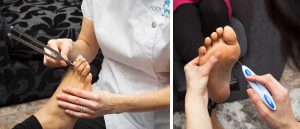It is absolutely essential that people with diabetes take good care of their feet as they are at risk of developing foot problems, particularly if their diabetes is poorly controlled or they have had diabetes for many years.
- Circulation can be reduced, healing may be slower and nerve damage can reduce sensation and ability to feel foot pain (neuropathy).
- Diabetic foot ulcers can arise in areas of increased pressure, underneath callus build up and even from small cuts and blisters.
- A person with diabetic neuropathy may not be able to feel these injuries and they may become larger or infected before they get noticed.

Diabetic foot checks monitor blood flow & check for nerve damage
Foot Checks
Having a diabetic foot ulcer increases risk of amputation and premature death, which is why it is extremely important that people with diabetes have good foot hygiene, wear well-fitted footwear and check feet daily for signs of any problems.
In addition, as per best practice guidelines, diabetic foot checks should be undertaken at least annually. Foot checks may be taken more frequently depending on your diabetic foot ulcer risk classification – make sure you are told what your risk is.
These can be done at your GP surgery or by a podiatrist.

Diabetic Foot Assessment at FootSmart Podiatry – checking for diabetic neuropathy using a tuning fork & monofilament
What happens at a diabetic foot assessment? Click here to find out or contact FootSmart Podiatry if you would like to arrange a diabetic foot check.
For further diabetic foot advice, visit the diabetes.org.uk website.

